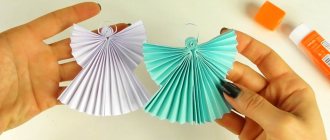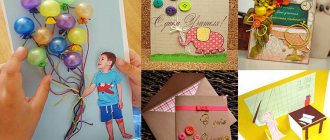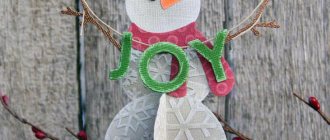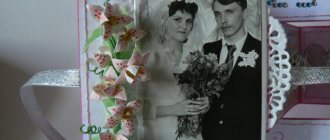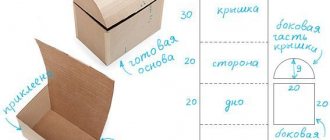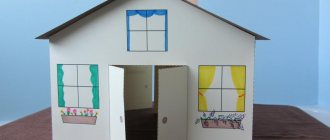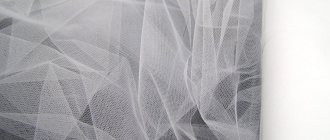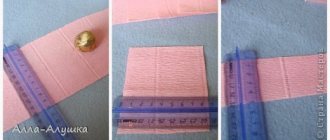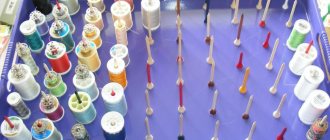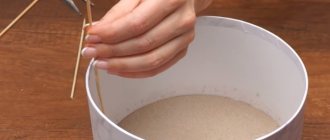Vases of various shapes and sizes are an integral element of interior decor, which creates comfort and a unique atmosphere in the house. You can make a vase yourself from various materials. For those who want to decorate their home with artificial flowers or dried flowers, a DIY cardboard vase is an excellent solution. The material for such a vase is available to everyone, and the finished product will look no worse than porcelain.
Finally, decorate with more colorful pebbles. You can also use sand of different colors. #1 All plants need light, and your terrarium is no exception. However, choose an indirect light location because the glass can act as a magnifying glass.
Floor-standing cardboard vase with original decor
#2 Mini gardens should remain warm, but it is good to avoid very high temperatures or rapid changes in the climate of the environment where it will be maintained. #3 Don't place the mini garden on furniture or bookshelves that are too thin and damaging. Try to leave them also in places out of the reach of children or pets.
Let's start working on our vase
First you need to cut a piece of cardboard tube to a suitable length. Trace the bottom on a piece of cardboard, cut it out and glue it with superglue.
Master class on making a vase from cardboard
#4 When choosing decorating objects to add to your mini garden, choose ones that are not easily damaged by water.
This is why aquarium decorations are great. Finally, do you know what is the coolest mini aquarium garden? It is that we are completely seduced by this small green world, protected and almost self-sufficient. Once it's ready, our role is simply to appreciate how wonderful it is and to appreciate the environment we've chosen for it. Oh, and here's a hint: they make great gifts! Since our vase will be made of cardboard and paper, we begin to work with it. We cut the magazine sheets into strips, fold them in half and roll them into small rolls, securing them with glue.
Glue the rolls to the pipe tightly to each other.
We also glue the top part.
The gaps between the rolls can be filled with any beads or buttons or, as in this example, with beans.
Building a home planter is a surprisingly simple and cost-effective operation that allows you to create all the pottery you need to meet all your specific needs. Planters can be used for outdoor or indoor use in all the shapes you want so you can make your plants and flowers any way you want.
Choose original shapes
You can create your own card shape or use already made shapes such as boxes of different sizes, containers of what you no longer use to small pre-made milk cartons. Each shape works well for this project. Of course, consider the type and number of plants you plan to cultivate in your home flower pots because this element will help you understand what the right size is for your planters and if you want to create a certain arrangement. this, you understand that you will need an outer mold and a mold of the same shape, but slightly different sizes.
We paint the entire product with bright paint and leave it to dry.
After this, we apply dark paint, and, without waiting for it to dry, we wipe off the excess with a sponge.
After drying, apply translucent gold paint to give the vase a noble shine. Then we cover it with 2-3 layers of transparent varnish. The vase is ready!
The gap between the two forms is exactly the future thickness of the walls of the planter. Obviously, if the size of your planter is more important, even the walls should be thicker. As we already expected, you can make your own perfect shapes by cutting two cardboard boxes to the desired size. You can also choose other materials such as glass, plastic and stainless steel. For this it works just as well. At this point, spray the inside of your molds with mineral oil or a release spray, which will help remove the mold later.
For the floor vase you will need
If you use a glass mold and one coated with lubricant, you may also not need to rip it apart when it takes time to get it out. Get a large bucket, tank or wheelbarrow where you can prepare your concrete mixture. Pour the required amount of material into the container, then add water and mix slowly until you reach the ideal consistency. When in doubt, follow the directions on the package.
How to make a floor vase with your own hands
This is a 2 part post on how to make a large floor vase. First about the blank, later it will become a vase.
Materials, parts, tools.
The tools you will need are scissors; it is better to take more, because cardboard is more difficult to cut than paper. Pen or pencil, glue gun. The material is corrugated cardboard. Newspapers. Cardboard tube. You can use plastic, buy sewer pipes at the construction market. They come in different diameters. You can buy cardboard at the construction market; linoleum and polyethylene are rolled on it. Can be found in printing shops. PVA glue is also used.
Browse products for inventors. Link to the store.
First, we apply the pipe to the cardboard and draw the outline of the future vase. It all depends on your imagination. Then cut out the first blank. Use it as a template. Draw the next one. One vase requires approximately 17 to 20 such blanks. They are glued along the entire length with a distance of 3-4 cm from each other. Most often there is no need to glue.
If the vase is tall, the piece needs to be cut in half. This will make it easier to glue. In this case, the height is 66 cm. If it is smaller, you can glue it directly in whole pieces. If it is even larger, cut into 3 parts. It will be more convenient this way.
DIY electronics in a Chinese store.
How to glue blanks?
Warm up the glue gun thoroughly. Place a few drops every 8-10 cm. We stick the cardboard on top and hold it there for a few seconds. It sets quite quickly. This is a big plus.
If something isn't straight, it's okay, it's the inside of the vase. It will be built up with other layers. So we cover the entire vase with blanks in a circle.
Now you need to cover the bottom with cardboard. It's easy to cut. We place the base on the cardboard and trace the outline along the edges. It turns out to be a circle. It's okay if it's uneven. Cut out this circle and glue it on.
Cover the vase with newspapers.
From newspapers we cut strips of 5-6 centimeters wide. We paste it with glue and coat the strips so that the paper is completely covered with PVA. The master does this on glass. We place the strips diagonally in the newspapers. But this is not important. In a chaotic manner.
In order not to waste time and materials, the master lays only one layer. It is better to paste over the top place with short strips. Covered completely with newspapers. Now let’s leave it to dry overnight in a warm place, for example near a radiator. Before work, PVA needs to be diluted with a little water so that it is more liquid, for ease of work. After drying, we will continue making our vase. Several hours passed. Everything has dried up. The paper stretched and the vase became stronger.
Cover the vase with papier-mâché
The master prepared papier-mâché. It's a doughy mess of toilet paper and glue. We take small pieces and stick around the workpiece. The work is labor-intensive, but you can’t do without this stage. Layer 3-5 mm. Apply and smooth the material using tapping movements with your fingers. If there are any unevenness, add a larger layer to cover it up. After the paper dried, ridges appeared. Here you need to apply a thicker layer to get a smooth shape. If the paper tears, the hole can be repaired with papier mache or putty. Sometimes lumps appear due to poor stirring. This should not be allowed. In this simple way we add rigidity to the vase. After drying, papier-mâché becomes as strong as wood. At this stage, perfect evenness is not required. Subsequently, everything will be smoothed out using putty.
Let it dry for 2 days near the radiator. After complete drying, we begin to putty. After 2.5 days the workpiece dried. The result is a durable structure. Tough and solid like wood. Now you can start puttingty.
Apply putty
For the first leveling layer we use putty. This is gypsum plaster for leveling walls. It can be cheaper or more expensive. And the master used a more elastic and smooth, more expensive one. It also dries faster. Cheap ones dry a little longer, the properties are the same. The base is sand, fine gypsum, and adhesive additives.
Pour 0.5 liters of water. Add putty. Stir with a spatula or mixer until a homogeneous mass is obtained, so that it is neither thick nor liquid. It is easy to stir as the mixture is fine grained. Therefore, you do not need to use any devices. Buy a rubber spatula. It's available at the hardware store. Designed for grouting joints on tiles. It is convenient for them to draw out all the curves on the vase. You can also do everything yourself.
The holes formed during gluing must be covered first, because they will dry out before the other layers. When working with your hands, it is better to use gloves, because there is cement in the mixture, it corrodes the skin. The first layer is applied to give the vase a more or less rounded shape.
We put the workpiece to dry. After a few hours, you can apply a second layer. If the putty is expensive, then it will take two to three hours. After the first layer has dried, the vase needs to be sanded. Sand the second and third layers with zero polish. Because the finishing putty is softer. To avoid scratching too much, you need scratch paper.
The vase should be even and smooth.
Prime the vase
Next you need to prime the surface. We use PVC diluted with water to a liquid state. Kiss. And cover the entire surface. Coat thoroughly until it is saturated. This will remove dust from the surface and give strength to the putty. After priming, place in a warm place for one hour to allow the PVA to dry.
The master created a vase with a narrow bottom. Since it is high and unstable, I poured 0.5 sand inside and filled it with plaster. Dries very quickly, literally in 3 minutes. Therefore, you should not be afraid that the cardboard will get wet.
We send the vase to dry. After the primer has dried, we send the vase for a second and third time. Finishing putty is used for finishing work. It is needed to level the surface more smoothly so that there are no flaws, scratches, or dimples.
Watch the master class on video
Channel “Master Sergeich”.
Decorating a floor vase
In the second part we will decorate the products and make flowers from cold porcelain. We will also paint and finish it until it is completely ready.
Second part
Let's start making a vase
To cut out the bottom for the vase, outline the bottom of the jar on cardboard and add 1 - 1.5 cm along the radius.
Unusual vase made from pieces of cardboard
When performing these operations, be sure to protect your hands with gloves. If you want to add embellishments to a particular composition, this is the right time to do so. Feel free to add colored wolves, pebbles, shells, marbles or any other decorative applications. Just try not to change the consistency of the concrete.
Pour concrete into the mold
Once the mixture is ready, pour the concrete evenly into the bottom of the mold, creating the base of the object. At this point you will have to worry about making two drainage holes. Then use a trowel to smooth the concrete mixture to achieve a uniform and uniform result.
The rest of the cardboard needs to be cut into thin strips of the same width of 1 - 1.5 cm. It is better to draw it using a ruler.
We cut the strips into fragments of 3 or 4 cm, depending on the diameter of the future vase.
We begin to assemble a cardboard vase. We glue the cardboard fragments along the edge of the bottom so that they do not cover the inner contour.
This is the time to insert the smaller mold inside and release the pressure on the mixture a little until you reach your desired thickness. Always consider that the base and walls should be the same thickness or at least a very similar thickness. Then pour concrete into all the cracks to make the walls and press the concrete mixture with a trowel until the space is saturated. Finally, make sure the edges of the mold are smooth and free of air bubbles.
The most difficult part of the work has already been completed. At this point, you'll have to do more than just let him rest for about 36 hours. Then test the strength of the concrete using a screwdriver or knife and make sure the cement has set well before removing the mold.
We paste the second row in a checkerboard pattern in relation to the first.
We continue to work according to the same scheme, periodically inserting the can to make sure that it fits.
Once the entire jar is closed, the work can be completed. Leave the craft to dry overnight, and then it can be used. If you leave the jar inside, you can put fresh flowers in it.
In this wonderful tutorial that we thought we offered to you, we want to try to understand and teach you all, for example, how to create newspaper jars in the simplest and easiest way. If we want to make decorative home decor in a simple and original way, we can do it with a newspaper card. In fact, we create the jars we collect using this product to recycle it for the better. Let's explain in this tutorial how the work happens step by step.
Newsprint Hot water Flour Vinyl glue Tempera colors Subwoofer Plastic container. First of all, we get a lot of newspapers, made from flour, which we use as glue and tempera dyes for painting this piece, a mixture between decoupages and papier paper. To begin, we cut the newspapers into small pieces, immersing them in a plastic container with hot water.
Wicker vases
A voluminous paper vase can be made by weaving, using colored cardboard or used juice packaging. Use scissors to cut many identical strips of paper and lay them out on the table surface. Weaving is done in a checkerboard pattern, intertwining the parts with each other.
If you are using packaging from a juice box, then the bottom is already there, and the weaving is done in a circle, adding strips cut from another container.
If the vase is made of thick paper, then for the bottom you can leave a whole square in the middle of the sheet. The edges of the strips are folded inward at the top and glued to the rest of the paper.
Stages of making a cardboard vase:
First you need to give the box a hexagonal shape.
Meanwhile, we take a plastic underlayer of plants, which we use as a support base. At this stage we use rolling paper so that we can create as many circles as we slide, one on top of the other, starting from the bottom of the underpass. Now let's take the flour and pour it into the container where we previously soaked the cuttings in vinegar. paper, and we start kneading until we get some kind of paper, soft and sticky. With our hands we make balls which we apply on a vase with the same flour paste and then wait for them to cool before we start working. When the jar created with the newspaper card is completely dry we take the tempera dyes and we We devote ourselves to the painting, choosing between a simple background or applying different colors, perhaps according to the shapes and friezes we have made with paper, water and flour.
We cut out triangles of different shapes from corrugated cardboard. Apply glue to the surface of the edge of the box and glue it with triangles, leaving gaps. We do the same with the remaining edges.
After the glue has dried, apply putty in the gaps.
Let the vase dry and paint with contrasting colors, darker in the spaces, lighter in the triangles. The vase is ready!
With this latest model you can model flowers or friezes to make the jar even more attractive. The processing process is complete, however we can add that if we want to create a vase with newspaper, this method can be done with a slight modification. In fact, if we take newspapers and instead of using them, we use them for half their length, we can directly create a funnel-shaped jar, which is then flattened towards the top so that it stands on the ground. Good job to all those who want to make you a sudden artist with our simple but really useful tips!
Floor decor item
To create a beautiful floor vase with your own hands, we will need:
- cardboard tube;
- corrugated or thick cardboard;
- PVA glue and thermal glue;
- scissors;
- newspapers;
- putty;
- sandpaper.
We create the base of the vase from a cardboard tube. It can be cut to the desired size.
Now we will make the curly walls of the vase. To do this, draw and cut out the blanks on thick cardboard. You need to make as many of them as possible to make the vase durable.
Glue the pipe to the base (cut out a circle with a larger diameter than the pipe itself). We glue the blanks around the entire perimeter of the vase, as shown in the photo.
Let's prepare the newspapers. Let's cut wide strips of them and use PVA glue to glue our entire vase blank. Apply glue again and leave to dry. Then we will process the papier-mâché shape: level it and dry it near the battery for at least a day, preferably more.
Next, we dilute the putty with water and PVA glue and coat the entire vase with the resulting mixture. Next you need to level the surface using sandpaper.
Related article: DIY candy ships with step-by-step photos and videos
And finally, the last stage is painting the vase. You can choose one or more colors and paint the vase in any way. It is best to use waterproof acrylic or varnish paint.
A beautiful and original handmade floor vase is ready!
Stages of making a floor vase:
We make a pattern for a vase with a height of 60 cm or more. There should be 4 faces with the same width in the central part, two of which are rectangular, and two are curly. We connect them with tape and cut out the bottom.
Let's start working on our vase
We all know a similar situation: here and there a glass of wine when there are only two left, and the other is the only one, completely different.
How about such a disparate collection? You use them for fruit cups for a while, sometimes you take a glass of orange juice in the morning, but over time everyone starts getting sick because you buy a new set. Flowers are constantly around me, even if there is only one small blooming landscape. Just a mug, empty glass that creates a nice whole with it. Especially now in spring, you will get a lot of small flowers in your hands. Blueberries, violets, chamomiles. They fit into two discarded glasses. Maybe luxurious chocolate - who wouldn't notice it on the table? Place the saucer on the cardboard and seal it. Cut out the wheel, mark the center and cut the paper vertically. Open the open ends in a wide cone and taste the glass. If the shape fits, glue the cone together with paper glue and finally cut off the tip so the flowers can fit through the hole.
We connect the edges with tape and attach the bottom. Cut out strips of paper and cover the neck with them. Until everything is dry, secure it with paper clips.
After drying, we begin to decorate the vase. Apply glue to the shells and glue them randomly. You can also come up with a suitable pattern. If desired, the vase can be decorated with any other materials.
The size of the hole depends on the volume of your plants. Pour fresh water into the glass so that the surface does not touch the paper. Flow the flowers through the hole in the cone and put them in the water. If you're working with double-sided cardboard, when choosing the right decor, the idea of an arrangement can be even more interesting.
In new vases, the blooming flower slowly opens, and the time when you can relax and enjoy a cup of tea or coffee is enchanting. Especially when good chocolate is hidden in a stream of beauty. Plastic and technical wheel program. “Each artist in his own way.” Artistic creativity is an extremely rich source of style. Teaches perseverance, responsibility, teamwork. The plastic wheel writing program gives the child the opportunity to act freely because artistic activity is the result of his creative expression.
The floor vase is ready!
